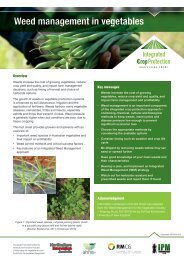vegetables
VA-NovDec2015
VA-NovDec2015
You also want an ePaper? Increase the reach of your titles
YUMPU automatically turns print PDFs into web optimized ePapers that Google loves.
36<br />
Economic Update<br />
The importance of<br />
understanding the consumer<br />
R&D<br />
Drive Train<br />
THE CONSUMER PLAYS A VITAL ROLE IN DETERMINING THE SIZE OF FARM<br />
PROFITS EVERY FINANCIAL YEAR. AUSVEG ECONOMIST ANDREW KRUUP<br />
EXPLAINS HOW GROWERS CAN OBTAIN AND COLLECT CONSUMER INFORMATION<br />
AND USE THIS TO IMPROVE THEIR OVERALL FINANCIAL PERFORMANCE.<br />
Percentage Change<br />
Growers are extremely<br />
knowledgeable of their<br />
product’s cost structures and the<br />
margins they would like to make,<br />
but often underestimate the<br />
consumer’s level of power and<br />
influence on the final price that<br />
is received from the market. After<br />
all, it’s the consumer who pays<br />
for the <strong>vegetables</strong> that are being<br />
produced.<br />
Given this, it is important for<br />
producers to know about their<br />
customers’ tastes, preferences,<br />
willingness-to-pay or the general<br />
consumer trends within the<br />
market place.<br />
Why is the consumer<br />
important?<br />
The human body requires<br />
vegetable nutrients for survival.<br />
The average annual Australian<br />
consumption of <strong>vegetables</strong><br />
is estimated to reach 162kg<br />
per capita and this statistic is<br />
expected to rise further into the<br />
future.<br />
A key determinant of growth<br />
in the vegetable industry is the<br />
domestic demand for <strong>vegetables</strong>,<br />
which is inextricably linked to<br />
Australia’s population growth.<br />
Figure 1: Australian Population Growth by State<br />
4.00%<br />
3.50%<br />
3.00%<br />
2.50%<br />
2.00%<br />
1.50%<br />
1.00%<br />
0.50%<br />
0.00%<br />
-0.50%<br />
-1.00%<br />
Population growth<br />
Figure 1 presents a time<br />
series of Australia’s population<br />
growth by state. Most states are<br />
experiencing population growth<br />
of around one per cent or<br />
greater per year, with Australia’s<br />
national population expected to<br />
increase by an estimated 1.7<br />
per cent annually.<br />
Australia’s growth in vegetable<br />
production (around two per<br />
cent per annum) is consistent<br />
with this population increase,<br />
illustrating the key relationship<br />
between population growth and<br />
vegetable production.<br />
To capitalise on this<br />
information, several questions<br />
need to be answered. For<br />
example, what <strong>vegetables</strong><br />
are these Australians likely to<br />
purchase in the future? It is<br />
well-known that over the past<br />
five years, there has been a<br />
stronger demand for healthier<br />
foods, but is this trend likely<br />
to continue? What <strong>vegetables</strong><br />
does the consumer perceive<br />
to be healthy? How can your<br />
business use this information<br />
to find a niche within the<br />
market? These questions can<br />
be answered through a deeper<br />
understanding of how the<br />
consumer thinks and operates.<br />
Jun-1982<br />
Nov-1983<br />
Apr-1985<br />
Sep-1986<br />
Feb-1988<br />
Jul-1989<br />
Dec-1990<br />
May-1992<br />
Oct-1993<br />
Mar-1995<br />
Aug-1996<br />
Jan-1998<br />
Jun-1999<br />
Nov-2000<br />
Apr-2002<br />
Sep-2003<br />
Feb-2005<br />
Jul-2006<br />
Dec-2007<br />
May-2009<br />
Oct-2010<br />
Mar-2012<br />
Aug-2013<br />
Jan-2015<br />
NSW VIC QLD SA WA TAS<br />
Source: Australian Bureau of Statistics, Australian Demographic Statistics, March 2015<br />
Figure 2: Vegetable Price Index<br />
Price Index<br />
160<br />
140<br />
120<br />
100<br />
80<br />
60<br />
40<br />
20<br />
0<br />
2005–06 2006–07 2007–08 2008–09 2009–10 2010–11 2011–12 2012–13 2013–14<br />
Price Index Potatoes Pumpkins Onions Carrots<br />
Source: Australian Bureau of Statistics, Australian Demographic Statistics, March 2015<br />
Cost of <strong>vegetables</strong><br />
Figure 2 illustrates that<br />
vegetable prices can fluctuate<br />
often. One explanation is<br />
that consumers can have<br />
a significant impact on the<br />
market prices for vegetable<br />
commodities. If consumers<br />
value a commodity less than<br />
the market price, they would<br />
be unwilling to purchase that<br />
commodity. The absence of<br />
customers wanting to purchase<br />
the commodity would translate<br />
into losses for both producers<br />
and retailers.<br />
In this case, the typical<br />
response by retailers and<br />
producers is to decrease the<br />
price to generate sales and<br />
regain profits. For example,<br />
if the average consumer<br />
values carrots at $2.00kg<br />
yet the asking price is set at<br />
$3.00kg, the likely outcome<br />
is that consumers would not<br />
buy carrots. If producers and<br />
retailers set the price below<br />
what the consumer is willing<br />
to pay, they are more likely to<br />
generate sales.<br />
It is through this market<br />
mechanism that the consumer<br />
is able to influence vegetable<br />
prices and therefore reduce<br />
(or improve) grower margins.<br />
The key to unlocking greater<br />
profitability is to research and<br />
understand what commodities<br />
are in high demand, how<br />
much consumers are willing to<br />
pay for them, and how these<br />
characteristics are likely to trend<br />
into the future.





